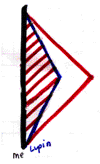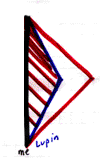




Jillian's Guide to Black Holes: Forming - Types - Outside - Inside - Finding - References - Websites
Light Rays and Time Dilation

Since you've got the basics, now you can have fun with light rays in spacetime diagrams. This one describes me standing still and watching Lupin fly off at some significant fraction of the speed of light and then coming back. While I was watching him, I flicked a flashlight on and off at pre-arranged time intervals. If you follow Lupin's worldline, you'll notice something funny. While I send my light rays off at a certain interval, in the first half of Lupin's journey he sees those light rays---but the intervals seem longer to him! He sees me and thinks I'm moving too slow! When he flies back towards me, the intervals he sees are now much smaller than the intervals I flick the flashlight (or they would be if I could draw straight lines right). He sees me moving much faster than normal! This distortion is called time dilation. It happens whenever someone moves, but it is more pronounced when they move at significant fractions of the speed of light.
The Symmetric Property of Funky Relativistic Effects

What do I see of him? Do I see time dilation for Lupin?
Sure I do! This diagram is of the same incident, but this time Lupin flicks a flashlight at pre-arranged time intervals as he flies (pretty dexterous for a bird!). While he's flying away from me, I perceive the intervals of light as larger than normal. While he's flying towards me, I see 'em as smaller than normal. Translation: while he flies away from me at some fraction of the speed of light, I think he's moving too slow; and while he flies towards me, I think he's moving too fast.
Great, so we've got spacetime diagrams with moving birds and people and light rays. We can draw a spacetime diagram for anything! Again, not quite. You can draw them for Lupin, who was flying with a constant speed. You can draw them for me, who was standing still. You can't draw them for me if I had gotten in a car and accelerated to 35 mph. Why not? It has to do with something called an inertial reference frame. That's a reference frame where Newton's laws of motion hold true. It's not an accelerated frame. Accleration is the change of velocity and/or the change of direction. Aha, you say, in those previous diagrams Lupin changed direction---gotcha! That's true. When Lupin changed direction, he was not inertial. The way I drew the diagrams, when he changed direction, he also experienced infinite acceleration (which would be the end of my poor bird, realistically). Eh, well, um...just leave it at 'inertial observers do not accelerate.'


